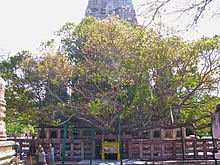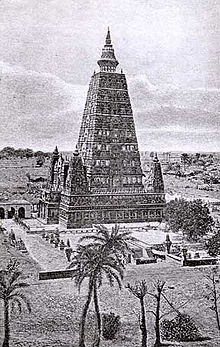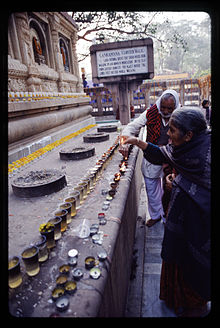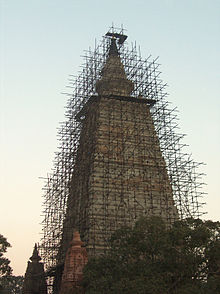- Mahabodhi Temple
-
Mahabodhi Temple Complex at Bodh Gaya * UNESCO World Heritage Site
Country India Type Cultural Criteria (i)(ii)(iii)(iv)(vi) Reference 1056 Region ** Asia-Pacific Coordinates 24°41′46″N 84°59′29″E / 24.696004°N 84.991358°ECoordinates: 24°41′46″N 84°59′29″E / 24.696004°N 84.991358°E Inscription history Inscription 2002 (26th Session) * Name as inscribed on World Heritage List
** Region as classified by UNESCOThe Mahabodhi Temple (महाबोधि मंदिर) (Literally: "Great Awakening Temple") is a Buddhist temple in Bodh Gaya, the location where Siddhartha Gautama, the Buddha, attained enlightenment. Bodh Gaya(located in Gaya district) is located about 96 km (60 mi) from Patna, Bihar state, India. Next to the temple, to its western side, is the holy Bodhi tree. In the Pali Canon, the site is called Bodhimanda,[1] and the monastery there the Bodhimanda Vihara. The tallest tower is 55 metres (180 ft) tall.
Contents
Buddhist legends concerning the site of the Mahabodhi Temple
The site of the Bodhi tree at Bodhigaya is, according to the Buddhist commentarial scriptures, the same for all Buddhas.[2] According to the Jatakas, it forms the navel of the earth,[3] and no other place can support the weight of the Buddha's attainment[4]
According to Buddhist mythology, if no Bodhi tree grows at the site, the ground around the Bodhi tree is devoid of all plants for a distance of one royal karīsa and nothing can travel in the air immediately above it, not even Sakka[clarification needed].[5]
Buddhist mythology also states that when the world is destroyed at the end of a kalpa, the Bodhimanda is the last spot to disappear and is the first to appear when the world emerges into existence again. The myth also claims that a lotus will bloom there, and if a Buddha is born during that the new kalpa, the lotus flowers in accordance with the number of Buddhas expected to arise.[6] According to legend, in the case of Gautama Buddha, a Bodhi tree sprang up on the day he was born.[7]
History
Rise of Buddhism
Traditional accounts say that, around 530 BC, Siddhartha Gautama, a young Indian Prince who saw the suffering of the world and wanted to end it, reached the sylvan banks of Falgu River, near the city of Gaya, India. There he sat in meditation under a peepul tree (Ficus religiosa or Sacred Fig), which later became known as the Bodhi tree. According to Buddhist scriptures, after three days and three nights, Siddharta attained enlightenment and the answers that he had sought. Mahabodhi Temple was built to mark that location.
The Buddha then spent the succeeding seven weeks at seven different spots in the vicinity meditating and considering his experience. Several specific places at the current Mahabodhi Temple relate to the traditions surrounding these seven weeks:
- The first week was spent under the Bodhi tree.
- During the second week, the Buddha remained standing and stared, uninterrupted, at the Bodhi tree. This spot is marked by the Animeshlocha Stupa, that is, the unblinking stupa or shrine, which is located on the north-east of the Mahabodhi Temple complex. There stands a statue of Buddha with his eyes fixed towards the Bodhi tree.
- The Buddha is said to have walked back and forth between the location of the Animeshlocha Stupa and the Bodhi tree. According to legend, lotus flowers sprung up along this route, it is now called Ratnachakarma or the jewel walk.
Construction
In approximately 250 BCE, about 2 years after the Buddha attained Enlightenment, Buddhist Emperor Asoka visited Bodh Gaya with the intention of establishing a monastery and shrine. As part of the temple, he built the diamond throne (called the Vajrasana), attempting to mark the exact spot of the Buddha's enlightenment, was established. Asoka is considered the founder of the Mahabodhi Temple. The present temple dates from the 5th–6th century,[8] although in the words of one scholar it is
largely a nineteenth-century British Archaeological Survey of India reconstruction based on what is generally believed to be an approximately fifth-century structure. Prior to 22 that, there seems to have been a pyramidal structure perhaps built in about the second century (Kuṣāṇa period). Knowledge of it comes only from a small, circa fourth century terracotta plaque found at modern Patna. It is significant that this version does not have the upper terrace with the small temples in the four corners. These small temples, although not used as such today, probably reflected certain esoteric traditions in Buddhism that were emerging more and more into less esoteric contexts by the late fourth and early fifth century. The pyramidal temple probably replaced an open pavilion that had been constructed around the tree and the Asokan platform . Representations of this early temple arc found at Sanci, on the toraṇas of Stūpa I, dating from around 25 BC, and on a relief carving from the stupa railing at Bhāhrut (Fig.20), from the early Śuṇga period (c. 185-c. 73 BC).[9]It is one of the earliest Buddhist temples built entirely in brick that is still standing in India, from the late Gupta period.
Decline
Buddhism declined when the dynasties patronizing it declined, following White Hun and the early Arab Islamic invasions such as that of Muhammad bin Qasim. A strong revival occurred under the Pala Empire in the northeast of the subcontinent (where the temple is situated). Mahayana Buddhism flourished under the Palas between the 8th and the 12th century. However, after the defeat of the Palas by the Hindu Sena dynasty, Buddhism's position again began to erode and became nearly extinct in India. During the 12th century CE, Bodh Gaya and the nearby regions were invaded by Muslim Turk armies. During this period, the Mahabodhi Temple fell into disrepair and was largely abandoned. Over the following centuries, the monastery's abbot or mahant became the area's primary landholder and claimed ownership of the Mahabodhi Temple grounds.
Restoration
In the 1880s, the then-British government of India began to restore Mahabodhi Temple under the direction of Sir Alexander Cunningham. A short time later, in 1891, the Sri Lankan Buddhist leader Anagarika Dharmapala started a campaign to return control of the temple to Buddhists, over the objections of the mahant. The campaign was partially successful in 1949, when control passed from the Hindu mahant to the state government of Bihar, which established a temple management committee. The committee has nine members, a majority of whom, including the chairman, must by law be Hindus.[10] Mahabodhi's first head monk under the management committee was Anagarika Munindra, a Bengali man who had been an active member of the Maha Bodhi Society.
Architectural style
Mahabodhi Temple is constructed of brick and is one of the oldest brick structures to have survived in eastern India. It is considered to be a fine example of Indian brickwork, and was highly influential in the development of later architectural traditions. According UNESCO, "the present temple is one of the earliest and most imposing structures built entirely in brick from Gupta period".[8]
Mahabodhi Temple's central tower rises 55 metres (180 ft), and were heavily renovated in the 19th century. The central tower is surrounded by four smaller towers, constructed in the same style.
The Mahabodhi Temple is surrounded on all four sides by stone railings, about two metres high. The railings reveal two distinct types, both in style as well as the materials used. The older ones, made of sandstone, date to about 150 BCE, and the others, constructed from unpolished coarse granite, are believed to be of the Gupta period (300–600 CE). The older railings have scenes such as Lakshmi, the Hindu goddess of wealth, being bathed by elephants; and Surya, the Hindu sun god, riding a chariot drawn by four horses. The newer railings have figures of stupas (reliquary shrines) and garudas (eagles). Images of lotus flowers also appear commonly.
Current status and management
Mahabodhi Temple is claimed as property of state government of Bihar, part of India. Under the terms of the Bodh Gaya Temple Act of 1949, the state government makes itself responsible for the protection, management, and monitoring of temple and its properties. The Act also has provisions for a Temple Management Committee, and an advisory board.
The Bodh Gaya Temple Management Committee is the executive body for management of the Mahabodhi Temple and certain adjoining areas. The TMC functions under the supervision, direction, and control of the state government of Bihar. By law, the Committee must consist of four Buddhist and four Hindu representatives, including the head of Sankaracharya Math monastery as an ex-officio Hindu member.[11] The Committee is chaired by the Gaya district magistrate, but if the Gaya district magistrate is not Hindu, the Act requires the government to appoint a Hindu chairman.[11] The Committee serves for a term of three years.[11] The Advisory Board consists of the governor of Bihar and twenty to twenty-five other members, half of them from foreign Buddhist countries.
In June 2002, the Mahabodhi Temple became a UNESCO World Heritage Site, specifically nominated for the international World heritage program.[11] All finds of religious artifacts in the area are legally protected under the Treasure Trove Act of 1878. The temple's head monk, as of September as of 2004[update], was Bhikkhu Bodhipala. Bodhipala resigned in 2007. Kalicharan Singh Yadav served as secretary until 2007. As of 2008, district magistrate Jitendra Srivastava was the Committee's chairman.[11] According to the Temple Management Committee's website, the current[update] chief priest is Bhikkhu Chalinda.[12]
Following the expiration of the Committee's term in September 2007, the government of Bihar delayed the appointment of a new Committee. The district magistrate has served as administrator for the temple pending the appointment of a new Committee.[11] Eventually, on May 16, 2008 the government announced the appointment of a new Temple Management Committee.[13]
Controversies and disputes
There have been several controversies regarding the temple involving both the management and care of the temple, and claims made by Hindus and Buddhists regarding ownership or rights of access to the temple.
In August 2005, individuals associated with the Bharatiya Janata Party (BJP) were stopped by police while attempting to enter the Mahabodhi Temple to make an offering of blessed water to a pedestal or broken pillar within the temple complex.[14] BJP officials claimed that a pedestal within the temple may be part of a Shiva linga, and that Hindus should be permitted access to the temple to make offerings to the pedestal.[14] Buddhist monks associated with the temple claim that this represents an attempt by Hindu nationalist elements to assert control over the temple, and to establish the primacy of Hinduism by advancing the claim that the Buddha was an incarnation of the god Vishnu.[14] They also claim that the structure which some Hindus have identified as a lingam is actually the broken base of a statue of the Buddha.[14]
In 2006, it was alleged that a branch of the bodhi tree had been removed and sold to wealthy buyers in Thailand with the cooperation of senior members of the temple's management committee.[15] Former temple secretary Kalicharan Yadav has denied this claim, contending that the branch was removed much earlier as part of a needed pruning effort recommended by botanists working with the temple.[15] Government officials denied the claim that the tree had been recently cut or harmed, providing pictures of the tree from previous years and organizing an outing led by the Bihar home secretary to examine the alleged damage to the tree.[16]
Arup Brahmachari, a Hindu monk, has called for investigations into the financial records of the temple, and the personal finances of individuals involved in running and managing the temple, alleging corruption among senior management.[15] Bhante Pragyadeep, treasurer of the Buddhist Monks Association of India, has also called for investigations into the temple's finances and the use of money donated to the temple.[15]
In September 2007, the three-year term of the Temple Management Committee ended. Rather than immediately appointing a new committee, the government of Bihar opted to appoint the Gaya District Magistrate, a former member of the Temple Committee, as sole administrator responsible for the temple.[11] As of March 2008, a new Committee has not been appointed to administer the temple, prompting criticism of the government by both Hindu and Buddhist leaders, with some Buddhists asserting that the government's delay was an attempt to exclude Buddhists from involvement in the administration of the temple.[11]
See also
Part of a series on
Buddhism
Dharma or concepts
Four Noble Truths
Five Aggregates
Impermanence
Suffering · Non-self
Dependent Origination
Middle Way · Emptiness
Karma · Rebirth
Samsara · CosmologyPractices
Three Jewels
Noble Eightfold Path
Morality · Perfections
Meditation · Mindfulness
Wisdom · Compassion
Aids to Enlightenment
Monasticism · LaityNirvāṇa
Four Stages · Arahant
Buddha · BodhisattvaTraditions · Canons
Theravāda · Pali
Mahāyāna · Chinese
Vajrayāna · Tibetan- Mahabodhi Temple, Bagan, Burma
- Wat Chet Yot, Chiang Mai, Thailand
References
- ^ In Pali, using Romanized diacritic marks, the word is spelled bodhimaṇḍa. In the Pali Canon, this term is found throughout the Buddhavamsa and, in one place, in the Jataka (Ja iv.238). Horner (2000) translates bodhimaṇḍa as "the dais of the Tree of Awakening" (e.g., pp. 15 v. 65, 25 v. 183, passim).
- ^ BuA.247
- ^ J.iv.233 (puthuvinābhi)
- ^ J.iv.229
- ^ J.iv.232f
- ^ DA.ii.412
- ^ DA.ii.425; BuA.248
- ^ a b "Mahabodhi Temple Complex at Bodh Gaya - UNESCO World Heritage Centre". Whc.unesco.org. 2002-06-26. http://whc.unesco.org/en/list/1056. Retrieved 2010-04-24.
- ^ "Sowing the Seeds of the Lotus: A Journey to the Great Pilgrimage Sites of Buddhism, Part I" by John C. Huntington. Orientations, November 1985 pg 61
- ^ Buddha Gaya Through the Ages. Delhi: Sri Satguru Publications. 1994. pp. 127–133. ISBN 81-7030-409-1.
- ^ a b c d e f g h Buddhists seek control over Mahabodhi temple management IANS. March 28, 2008. Retrieved March 29, 2008.
- ^ [1][dead link]
- ^ "Holiest Buddhist shrine gets governing panel, finally". Thaindian.com. 2008-05-17. http://www.thaindian.com/newsportal/uncategorized/holiest-buddhist-shrine-gets-governing-panel-finally_10049792.html. Retrieved 2010-04-24.
- ^ a b c d Buddhist monks rue BJP's claim over Mahabodhi temple. August 24th 2005. Retrieved on March 27, 2008.
- ^ a b c d Scandal gnaws at Buddha's holy tree in India. Denyer, Simon. Reuters News Service. February 3, 2008. Retrieved March 27, 2008.
- ^ No damage to Bodhi tree: Govt. Singh, Sanjay. July 21, 2006. Retrieved March 27, 2008.
Sources
- Horner, I.B. (trans.) (1975; reprinted 2000). The Minor Anthologies of the Pali Canon (Part III): 'Chronicle of Buddhas' (Buddhavamsa) and 'Basket of Conduct' (Cariyapitaka). Oxford: Pali Text Society. ISBN 0-86013-072-X.
External links
 Media related to Mahabodhi Temple at Wikimedia Commons
Media related to Mahabodhi Temple at Wikimedia Commons- Land Enlightenment of the Buddha
- Bodhgaya News
- UNESCO World Heritage
- The Bodh Gaya temple controversy
- Mahabodhi Temple Video Tour - Video Gallery of main sites in Mahabodhi Temple, narrated in Sinhalese.
World Heritage Sites in India North Agra Fort · Buddhist Monuments at Sanchi · Fatehpur Sikri · Humayun's Tomb · Keoladeo National Park · Khajuraho Group of Monuments · Mountain Railways of India (Kalka-Shimla Railway)1 · Nanda Devi and Valley of Flowers National Parks · Qutub Minar and its Monuments · The Red Fort complex · Rock Shelters of Bhimbetka · Taj Mahal
Northeast East Mahabodhi Temple Complex at Bodh Gaya · Mountain Railways of India (Darjeeling Himalayan Railway)1 · Sun Temple at Konark · Sundarbans National Park
South Great Living Chola Temples at Thanjavur, Gangaikonda Cholapuram and Darasuram · Group of Monuments at Hampi · Group of Monuments at Mahabalipuram · Group of Monuments at Pattadakal · Mountain Railways of India (Nilgiri Mountain Railway)1
West Ajanta Caves · Champaner-Pavagadh Archaeological Park · Chhatrapati Shivaji Terminus · Churches and convents of Goa · Elephanta Caves · Ellora Caves · Jantar Mantar
1 Shared with other region/s Categories:- 3rd-century BC establishments
- Buddhist temples in India
- Buildings and structures in Bihar
- Hindu temples
- Hindu World Heritage Sites
- Religion in Bihar
- World Heritage Sites in India
Wikimedia Foundation. 2010.







